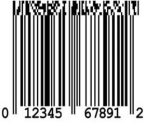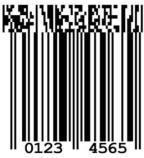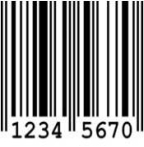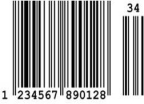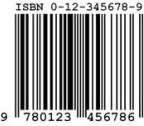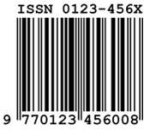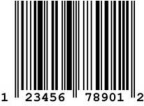One-dimensional bar code symbologies
|
Bar code |
Forms and Bar Code Card |
Forms Composer v3.3.9 |
Document Producer |
Optra Forms |
Sample image |
Description |
|||
|---|---|---|---|---|---|---|---|---|---|
|
v3.3 |
v3.2 |
v3.1 |
v3.0 |
||||||
|
1 One-dimensional bar code symbologies supported by Bar Code Card version 2.4 or later can be printed with Optra Forms when:
2 These bar codes are not available in PCL 5 emulation or PostScript emulation. |
|||||||||
|
Codabar |
Y |
Y |
Y |
Y |
Y |
Y |
Y 1 |

|
Codabar, also known as USD-4, NW-7, Monarch, or Code 2 of 7, is a variable-length symbology that allows encoding of the following characters: 0 1 2 3 4 5 6 7 8 9 - $ : / . + A B C D . |
|
Codabar with mod16 check digit |
Y |
Y |
Y |
Y |
Y |
Y |
Y 1 |
||
|
Codablock F |
Y 2 |
Y |
Y |
Y 2 |
Y |
Y |
N |

|
Codablock F is a stacked version of the standard bar codes Code 39 and Code 128. Row indicators show the orientation of the reading, and two check characters guarantee the accuracy of the data encoded. There are three varieties of this code. Codablock F can contain 2 to 44 rows, with 4 to 62 characters per row. This symbology can encode up to 2725 characters. |
|
Code 3 of 9 |
Y |
Y |
Y |
Y |
Y |
Y |
Y |

|
Code 3 of 9, also known as Code 39 or AIM USS 39, is the first alphanumeric code that shows the digits from 0 to 9, 26 letters (uppercase A to Z), and seven special characters: - . * $ / + % and space. Code 3 of 9 has no built-in checksum. |
|
Code 3 of 9 with check digit |
Y |
Y |
Y |
Y |
Y |
Y |
Y |
Code 3 of 9 optionally allows for a Modulo 43 check character in cases where data security is important. |
|
|
Code 3 of 9 extended |
Y |
Y |
Y |
Y |
Y |
Y |
Y |
Code 3 of 9 extended is a general-purpose code that can code any ASCII character that you can enter from the keyboard by normal means. Similar to the standard 3 of 9 code, data can be of any length. |
|
|
Code 3 of 9 extended with check digit |
Y |
Y |
Y |
Y |
Y |
Y |
Y |
Code 3 of 9 extended also optionally allows for a Modulo 43 check character in cases where data security is important. |
|
|
Code 93 |
Y |
Y |
Y |
Y |
Y |
Y |
Y 1 |

|
Code 93 is a variable-length symbology that can encode the complete 128 ASCII character set. It also incorporates two check digits as an added measure of security. |
|
Code 93 extended |
Y |
Y |
Y |
Y |
Y |
Y |
Y 1 |
Similar to Code 93, except that it allows the complete 128 ASCII character set to be encoded. |
|
|
Code 128 |
Y |
Y |
Y |
Y |
Y |
Y |
Y |




|
Code 128, also known as USS 128, is a general-purpose bar code that can handle any ASCII character. It also allows encoding of four special function codes (FNC1 to FNC4). Code 128 can encode data of any length. |
|
HIBC 128 or HIBC 39 |
Y 2 |
Y |
Y |
Y 2 |
Y |
Y |
N |

|
HIBC has versions based on Code 3 of 9, Code 128, and Codablock F, and uses standard bar code encoding. The uniqueness of the bar codes comes in the structure of the data that is encoded. The HIBC standard provides for a Supplier Standard and a Provider Standard, each with its own unique data structure. |
|
Industrial 2 of 5, Standard 2 of 5, or Code 25 |
Y |
Y |
Y |
Y |
Y |
Y |
Y 1 |

|
Industrial 2 of 5 is a numeric-only bar code. Industrial 2 of 5 has no built-in checksum. |
|
Industrial 2 of 5 with check digit |
Y |
Y |
Y |
Y |
Y |
Y |
Y 1 |
Industrial 2 of 5 optionally allows for a check character in cases where data security is important. |
|
|
Interleaved 2 of 5 |
Y |
Y |
Y |
Y |
Y |
Y |
Y |

|
Interleaved 2 of 5 encodes digit pairs in an interleaved manner. Each data character is composed of five elements, either five bars or five spaces. Of these five elements, two are wide and three are narrow. Each digit has its own unique two-out-of-five arrangement. A complete Interleaved 2 of 5 symbol consists of the following:
For general-purpose, free-form numeric data, this bar code is the most efficient code available. Interleaved 2 of 5 has no built-in checksum. |
|
Interleaved 2 of 5 with check digit |
Y |
Y |
Y |
Y |
Y |
Y |
Y |
Interleaved 2 of 5 optionally allows for a weighted Modulo 10 check character in cases where data security is important. |
|
|
ITF-14 |
Y |
Y |
Y 2 |
Y |
Y |
Y |
N |

|
ITF-14 is an Interleaved 2 of 5 bar code with bearer bars surrounding the bar code. |
|
Matrix 2 of 5 |
Y |
Y |
Y |
Y |
Y |
Y |
Y 1 |

|
A variation of Interleaved 2 of 5, Matrix 2 of 5 is mainly used in the Netherlands. |
|
Matrix 2 of 5 with check digit |
Y |
Y |
Y |
Y |
Y |
Y |
Y 1 |
Matrix 2 of 5 optionally allows for a check character in cases where data security is important. |
|
|
MSI or MSI Plessey |
Y |
Y |
Y |
Y |
Y |
Y |
Y 1 |

|
MSI is a numeric-only bar code type. It can accept a variable number of digits up to 13. |
|
MSI with mod10 check digit |
Y |
Y |
Y |
Y |
Y |
Y |
Y 1 |
MSI bar code can include a Modulo 10 checksum. |
|
|
MSI with mod10 and mod10 check digit |
Y |
Y |
Y |
Y |
Y |
Y |
Y 1 |
MSI bar code can include a Modulo 10 checksum, and may include a second checksum. If a second checksum is required, then the first checksum is appended to the original string. The checksum calculation is performed again including the first checksum. |
|
|
MSI with mod11 and mod10 check digit |
Y |
Y |
Y |
Y |
Y |
Y |
Y 1 |
Some applications may require a Modulo 11 checksum, and it is calculated differently from the Modulo 10 checksum. |
|
Two-dimensional bar code symbologies
|
Bar code |
Forms and Bar Code Card |
Forms Composer v3.3.9 |
Document Producer |
Optra Forms |
Sample image |
Description |
|||
|---|---|---|---|---|---|---|---|---|---|
|
v3.3 |
v3.2 |
v3.1 |
v3.0 |
||||||
|
1 PDF417 and MaxiCode can be printed with Optra Forms only when:
2 One-dimensional bar code symbologies supported by Bar Code Card version 2.4 or later can be printed with Optra Forms when:
3 These bar codes are not available in PCL 5 emulation or PostScript emulation. |
|||||||||
|
Data Matrix |
Y 3 |
Y |
Y |
Y 3 |
Y |
Y |
N |
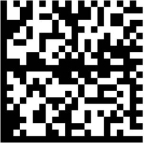
|
Data Matrix employs the Reed-Solomon error correction with data redundancy to guarantee a fast and accurate read. The symbol can store between 1 and 3116 numeric or 2335 alphanumeric characters. Data Matrix is scalable up to a 14-in. sq., but the actual limits depend on the fidelity of the marking device and the optics of the reader. |
|
MaxiCode |
Y |
Y |
Y |
Y |
Y |
Y |
Y 1 |
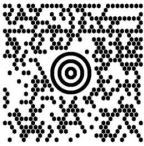
|
MaxiCode is a medium-capacity two-dimensional matrix bar code symbology especially designed for the high-speed scanning application of package sorting and tracking. |
|
MicroPDF417 |
Y 3 |
Y |
Y |
Y 3 |
Y |
Y |
N |
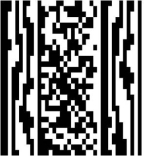
|
MicroPDF417 is a multi-row symbology derived from and closely based on PDF417. It is designed for applications with a need for improved area efficiency but without the requirement for PDF417 maximum data capacity. A limited set of symbol sizes is available, together with a fixed level of error correction for each symbol size. |
|
PDF417 |
Y |
Y |
Y |
Y |
Y |
Y |
Y 1 |
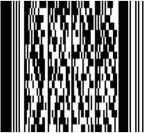
|
PDF417 is a high-density two-dimensional bar code symbology that consists of a stacked set of smaller bar codes. It can encode the complete ASCII set. |
|
QR Code |
Y |
Y |
Y |
Y |
Y |
Y |
N |
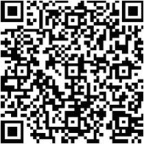
|
QR Code is a matrix code. The maximum symbol size is 177 modules square. It can encode 7366 numeric characters or 4464 alphanumeric characters. |
|
Swiss QR Code |
Y |
Y |
Y |
Y |
Y |
Y |
N |
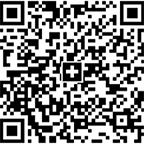
|
The Swiss QR code is always generated with the ECC level (M) . The PCL P-Parameter must always be triggered to the value of 2p . The module size varies depending on the QR code version chosen for the data amount to encode because the label size must be 46 x 46 |
Composite bar code symbologies
Postal bar code symbologies
|
Bar code |
Forms and Bar Code Card |
Forms Composer v3.3.9 |
Document Producer |
Optra Forms |
Sample image |
Description |
|||
|---|---|---|---|---|---|---|---|---|---|
|
v3.3 |
v3.2 |
v3.1 |
v3.0 |
||||||
|
1 One-dimensional bar code symbologies supported by Bar Code Card version 2.4 or later can be printed with Optra Forms when:
2 These bar codes are not available in PCL 5 emulation or PostScript emulation. |
|||||||||
|
Australia Post 4-State |
Y |
Y |
Y |
Y |
Y |
Y |
Y 1 |
aust_post_37_customer 
aust_post_45_reply 
aust_post_52 customer 
aust_post_67 customer 
|
A 4-State bar code is similar in appearance to RM4SCC, but with different methods of encoding characters and checksum algorithm. It also has a different set of start and stop bars. Symbols can encode one of three different amounts of data, allowing varying quantities of customer-specific data to be added to the basic postal delivery information. |
|
RM4SCC |
Y |
Y |
Y |
Y |
Y |
Y |
Y 1 |

|
RM4SCC is used in the United Kingdom. It can encode up to 128 different characters, but only A to Z and 0–9 have been assigned unique bar patterns. |
|
Danish PTT 3 of 9 |
Y |
Y |
Y |
Y |
Y |
Y |
Y 1 |

|
This symbology is a modified 3 of 9 bar code. |
|
Dutch Post 4-State |
Y |
Y |
Y |
Y |
Y |
Y |
Y 1 |

|
This symbology consists of a six-character postcode (four digits followed by two letters). Any of the following may follow: a 1–5-digit house, postbox, or freepost number; a separator character ( x ); and a 1–6-character house number extension (digits or letters). |
|
French Postal 3 of 9 A/R |
Y |
Y |
Y |
Y |
Y |
Y |
Y 1 |

|
This symbology is a modified 3 of 9 bar code. |
|
German Postal 2 of 5 Identcode |
Y |
Y |
Y |
Y |
Y |
Y |
Y 1 |

|
This symbology is a modified 2 of 5 bar code for parcels to encode the following:
|
|
German Postal 2 of 5 Leitcode |
Y |
Y |
Y |
Y |
Y |
Y |
Y 1 |

|
This symbology is a modified 2 of 5 bar code for parcels to encode the following:
|
|
Intelligent Mail |
N |
N |
Y |
N |
N |
Y |
N |

|
The USPS uses this symbology to sort and track letters and flats. Intelligent Mail combines the capability of POSTNET and PLANET bar codes into a single bar code. |
|
Japan Post 4-State |
Y |
Y |
Y |
Y |
Y |
Y |
Y 1 |

|
This symbology is similar to RM4SCC except for the rules about specific postcode data that can be encoded. It consists of a seven-digit postal code number. A block and house number may follow. The encoded data can include hyphens. |
|
PLANET |
Y 2 |
Y |
Y |
Y 2 |
Y |
Y |
N |

|
This symbology is the inverse of POSTNET. Each PLANET digit has three tall and two short bars. All PLANET bar codes include a five-bar checksum digit or correction character. |
|
Singapore 4-State |
Y |
Y |
Y |
Y |
Y |
Y |
Y 1 |

|
This symbology is identical to RM4SCC except for the rules about specific postcode data that can be encoded. |
|
Swiss Post 3 of 9 |
Y |
Y |
Y |
Y |
Y |
Y |
Y 1 |

|
This symbology is a special version of Code 128 C. Data consists of an 18-digit identification code composing of the following:
|
|
USPS FIM |
Y |
Y |
Y |
Y |
Y |
Y |
Y |
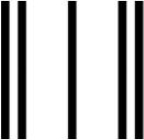
|
FIM is used by the USPS canceling machines to sort mail according to its postage requirements and whether it is bar-coded. |
|
USPS POSTNET 5-digit ZIP code |
Y |
Y |
Y |
Y |
Y |
Y |
Y 1 |

|
POSTNET encodes numbers to represent the following:
|
|
USPS POSTNET 9-digit ZIP with 4 code |
Y |
Y |
Y |
Y |
Y |
Y |
Y |

|
|
|
USPS POSTNET 11-digit Delivery Point code |
Y |
Y |
N |
Y |
Y |
Y |
Y |

|
|
|
USPS sack label 8-digit 2 of 5 |
Y |
Y |
Y |
Y |
Y |
Y |
Y 1 |

|
This symbology is a modified Interleaved 2 of 5 code. The bar code encodes the following:
|
|
USPS tray label 10-digit 2 of 5 |
Y |
Y |
Y |
Y |
Y |
Y |
Y 1 |

|
This symbology is a modified Interleaved 2 of 5 code. The bar code encodes the following:
|
|
USPS Zebra code |
Y |
Y |
Y |
Y |
Y |
Y |
Y 1 |

|
The Zebra code is used by the USPS on tray labels to serve as a visual indication that the tray contains bar-coded automation-rate mail. Bar code readers do not read it. It consists of a series of diagonal or vertical marks. Each line must be 0.250 in. to 0.375 in. (6.35 mm to 9.52 mm) high, 0.125 in to 0.250 in. (3.18 mm to 6.35 mm) wide. Separate these lines with blank spaces equal in size to the line widths. |
